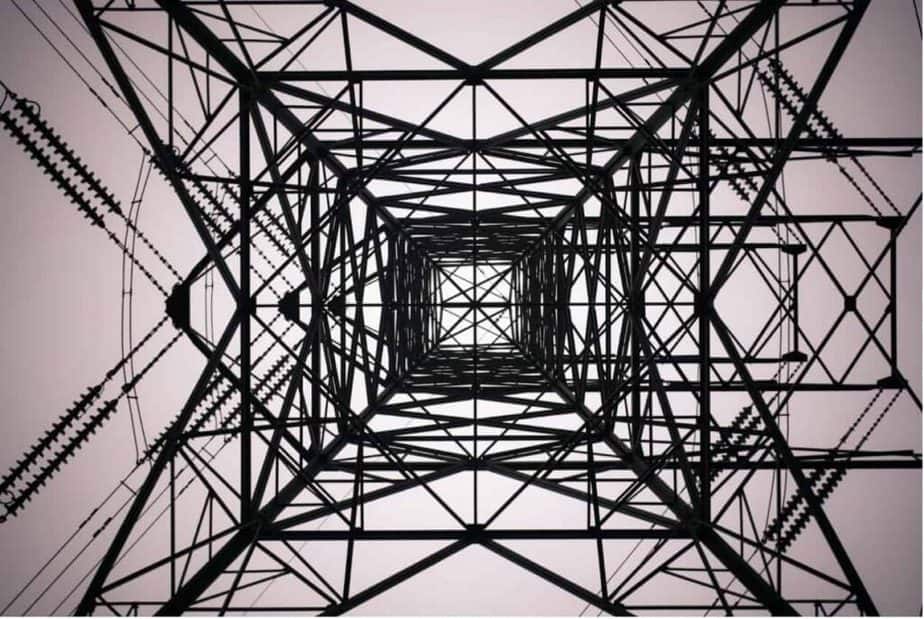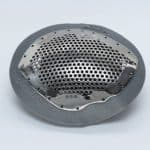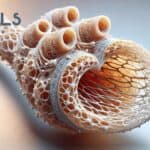
Dr. Jenny Chen is trained as a neuroradiologist, founder/CEO of 3DHEALS. Her main interests include medical education, 3D printing in the healthcare sector, and artificial intelligence. She is also a current adjunct clinical faculty in the radiology department at Stanford Healthcare.
Tell us a little about yourself and how you ended up specializing and developing an expertise in 3D Printing in Healthcare?
Jenny: The first time I ever touched a 3D printed anatomical model was during 2011 RSNA, and that moment was transformative. Throughout our professional lives as radiologists, we are used to reconstructed black and white 2D images from the monitors into a 3D structure in our minds and formulate a story around it for the patient. For the first time in my life, I am in the same physical world with the patient’s illness. That barrier between the digital world and physical world has been suddenly removed. What was entirely in the digital world can now be in the physical world, and I could interact with it. That experience was amazing and at the same time perplexing. I think that is the moment when pure “human-computer interaction” happens. Some of this experience still cannot be verbalized or understood, and I think that is still fascinating. We are now at a time when information can be freely transferred between the digital world and the physical world with the availability of digital manufacturing.
What is 3DHEALS?
Jenny: All the good names were taken, so we ended up with “3DHEALS”.
3DHEALS is a platform for people to learn about the power of 3D printing and people who want to use it to create meaningful solutions in the healthcare vertical. As a company, our first goal is to create opportunities for people to learn new skills, science, and truth about the technology and not the hype. In fact, the media hype often overshadows the true power of the technologies. We believe this technology will create many new job opportunities in the healthcare industry.
In the past six months, we have also started to achieve our second mission of connecting the world, by creating healthcare 3D printing communities all over the world. We now have more than 15 passionate community managers in 12 cities globally, and that aspect of the company is growing organically. We did not expect this kind of expansion, but we are delighted to see the curiosity and passion for our communities. It is very touching.
Finally, we want to help organizations and lawmakers with understanding healthcare needs and facilitate conversations among healthcare providers, policymakers, and industries so that everyone can be on the same page to solve problems faced by the industry. Both healthcare and manufacturing are highly regulated and complex systems, and it is an important often missed point that people from these different systems cannot communicate effectively. We just had our first executive programs last week in Washington DC.
What is hype and what is the reality around 3D Printing
Jenny: Hype: Ignore all the projected numbers of industry analysts. Little kids or NFL players are the perfect PR people, but the glamorous photos with their prosthesis or arm casts overshadow what can really be done with this trillion-dollar worth technology that is currently under-developed in the healthcare vertical, where I personally believe will deliver the first breakthrough innovations using 3D printing. People may be awed by the media photos and stopped to learn the true power of the technology.
What is the reality? One concept, complexity for free, is revolutionary. Complex geometries that are impossible to produce by conventional manufacturing can now be produced by 3D printing at no additional cost. That is a miracle. That is zero-to-one.
What is also reality is that Align Technology (the company that makes Invisalign) has quietly used the technology to build a company that is now worth 20 billion dollars over the last twenty years, with 1 billion dollars annual revenue. Few other companies have done this. Align is making profits because it is producing a much cheaper, convenient, and better product for the patients compared to the traditional dental braces. When there is value, patients will recognize it and reward it. That’s reality. If no one is paying for it, then it is a hype. Reimbursement worries should be included in the discussion, but my question is always if anyone is willing to pay for it without reimbursement. That is a kind of litmus test.
Where is the real impact and where should researchers, industry, and healthcare professionals focus to leverage the true impact of 3D?
Jenny: That is an expensive question and I think many companies and entrepreneurs are dying to know the answer to that. I think what I can make an impact in the space RIGHT NOW is by achieving 3DHEALS’ three missions: education, connecting the world, and facilitate conversations in policies/standardization.
Name some innovators and changemakers in the field? Why are they change makers?
Jenny: Over the last two years, I have had the fortune to encounter a series of entrepreneurs in the space. I have concluded that these people share two common characteristics: 1. They are intimately experienced with the illness. They are emotionally invested in solving the problem, which makes them super focused. 2. They are very educated about the technologies and have access to them.
For example, Jeff Huber, the CEO of Standard Cyborg, was born with lower extremity congenital abnormality and needed to get fitted prosthesis all his life. Now that he is an engineer, he invented a more efficient and effective 3D printing digital workflow for making the prosthesis. Dr. Christopher Hart is a dentist from Australia, whom himself suffer sleep apnea. He founded the company Oventus, which creates the 3D printed mouthpiece for sleep apnea patients. There are many more stories like these.
Who inspired you the most along this journey in 3D printing? This can be a mentor, a patient, a celebrity, anyone basically. You can name more than one as well.
Jenny: There are so many! All the speakers for 3DHEALS2017 and 3DHEALS2018 to begin with. Everyone has a unique and impressive record, vision, and hardships. Most importantly, all of them went in this challenging field with a gusto. They are the ultimate “intelligent” risk takers. They are equipped with knowledge but not intimated by the knowledge of potential failure.
What motivates you the most for your work?
Jenny: The people! There is no doubt. It is an enjoyment to be able to discuss ideas with whom I believe to be the most inspiring and smartest people in the world. It is a great feeling to have when you are with a group of people who not only do not think your ideas are crazy, but they encourage you to have more of those ideas. These people are actively working on solutions for them as well. I feel our brainwaves are in sync.
The people in 3DHEALS community is the biggest driving force behind my work.
(Photo: 3DHEALS community from Spain, Germany, Canada, Dubai, and more)
What is/are the biggest obstacle(s) in your line of work? If you have conquered them, what were your solutions?
Jenny: Status quo.
My role is to promote startups, innovators, early healthcare adopters while being agnostic of their affiliation. Good technologies, stories, and practices should be known to everyone because this will inspire others either in a garage labor in a large academic institution to invent new solutions for us all. 3DHEALS will be that vessel to achieve this goal.
If you are granted three wishes by a higher being, what would they be?
Jenny:
- · More innovations/startups in healthcare 3D printing and bio-printing.
- · Less expensive regulatory approval process.
- · Replacement tissue and organs becoming a reality soon.
What advice would you give to a smart driven college student in the “real world”? What bad advice you heard should they ignore?
Jenny: Despite being a product of decades of academic training and often “teacher’s pet”, I hate schools. I think the current established academic institution is doing a disservice to our young people. If I knew what I know now while in college, my number one task would be to learn more about myself. This is not cliché. Knowing oneself well will allow you to define a goal that will be a better motivation than anyone else’ dream or influence. That’s the homework that will not be scored but so much more important as a young person. Find the best adventure and journey you would like to spend your life energy on. You can play a game that is designed by others, or you can design your original version. How exciting can that be?
Bad advice: Bad advice often comes from people who love and care about you the most. Mine came from my mother when it comes to career choices. She wants me to have a “relaxing job” and was against of me taking up a career in medicine because it is an obviously stressful job and will delay what a woman in her times need to accomplish: family and kids. While I love my family, looking back, had I become anything but a physician, my life will be a disappointment to MYSELF.
What was/is the biggest risk you took in your career?
Jenny: I can live a very comfortable life as a radiologist. Founding 3DHEALS is one of the biggest risks I took. Not only I now have zero leisure time, I have received more rejections than I ever have in my life, and it still hurts. But the vision for the field and the people in 3DHEALS community keep me going.
What do you enjoy in your spare time? What are you passionate about outside of your work/3d printing?
Jenny: I enjoy playing drums/music with a few good friends. It is a priority for me to make time for my family and friends. I think 3D Printing/bio-printing really occupy most of our leisure time at this time. It is such a fascinating field and well worth my time. Fortunately, I have a lot of friends in the field. =)




 Mar 29, 2018
Mar 29, 2018 






Wonderful Dr.Chen. Kudos to your Spirit and enthusiasm. Let’s heal the world. I like your Vision and passion. Please let me know, what all necessary to become a Start-up in 3D Heals healthcare industry. I myself a Start-up in Technology and Wireless/ICT/Satellite/Communications platform to Connect the World with Underprivileged, Upliftment of the poor, Socioeconomic development, Education and food for everyone. Most focus on Children and Development with creation new Business opportunities. Ultimately this will create several Jobs / employment around the targeted Underprivileged, underdevelopment and Insurgency hit economies. But my sudden deadly road disaster 04+ years back put a block in the Course. Still it’s ok, I’m much better now and working Online/offline. All ideas are perfectly well set now. Only action necessary, at present I’m eagerly Looking for funds for my Start-up and the rest of my Treatment left/Orthopedic-Left hand elbow joint injury and remains of the brain injury treatment. That’s all. Thanking you and with best of the wishes-
Sambit